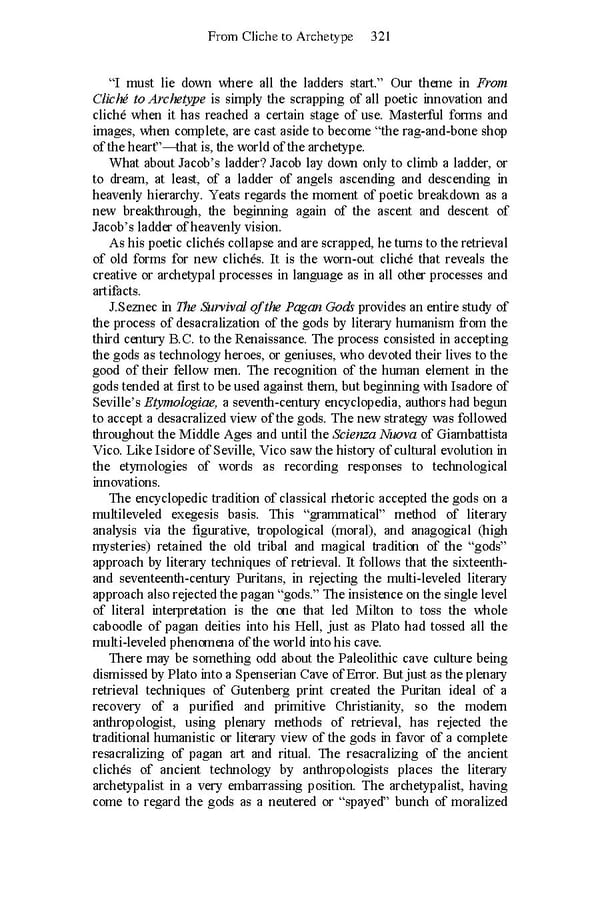From Cliche to Archetype 321 “I must lie down where all the ladders start.” Our theme in From Cliché to Archetype is simply the scrapping of all poetic innovation and cliché when it has reached a certain stage of use. Masterful forms and images, when complete, are cast aside to become “the rag-and-bone shop of the heart”—that is, the world of the archetype. What about Jacob’s ladder? Jacob lay down only to climb a ladder, or to dream, at least, of a ladder of angels ascending and descending in heavenly hierarchy. Yeats regards the moment of poetic breakdown as a new breakthrough, the beginning again of the ascent and descent of Jacob’s ladder of heavenly vision. As his poetic clichés collapse and are scrapped, he turns to the retrieval of old forms for new clichés. It is the worn-out cliché that reveals the creative or archetypal processes in language as in all other processes and artifacts. J.Seznec in The Survival of the Pagan Gods provides an entire study of the process of desacralization of the gods by literary humanism from the third century B.C. to the Renaissance. The process consisted in accepting the gods as technology heroes, or geniuses, who devoted their lives to the good of their fellow men. The recognition of the human element in the gods tended at first to be used against them, but beginning with Isadore of Seville’s Etymologiae, a seventh-century encyclopedia, authors had begun to accept a desacralized view of the gods. The new strategy was followed throughout the Middle Ages and until the Scienza Nuova of Giambattista Vico. Like Isidore of Seville, Vico saw the history of cultural evolution in the etymologies of words as recording responses to technological innovations. The encyclopedic tradition of classical rhetoric accepted the gods on a multileveled exegesis basis. This “grammatical” method of literary analysis via the figurative, tropological (moral), and anagogical (high mysteries) retained the old tribal and magical tradition of the “gods” approach by literary techniques of retrieval. It follows that the sixteenth- and seventeenth-century Puritans, in rejecting the multi-leveled literary approach also rejected the pagan “gods.” The insistence on the single level of literal interpretation is the one that led Milton to toss the whole caboodle of pagan deities into his Hell, just as Plato had tossed all the multi-leveled phenomena of the world into his cave. There may be something odd about the Paleolithic cave culture being dismissed by Plato into a Spenserian Cave of Error. But just as the plenary retrieval techniques of Gutenberg print created the Puritan ideal of a recovery of a purified and primitive Christianity, so the modern anthropologist, using plenary methods of retrieval, has rejected the traditional humanistic or literary view of the gods in favor of a complete resacralizing of pagan art and ritual. The resacralizing of the ancient clichés of ancient technology by anthropologists places the literary archetypalist in a very embarrassing position. The archetypalist, having come to regard the gods as a neutered or “spayed” bunch of moralized
 Essential McLuhan Page 327 Page 329
Essential McLuhan Page 327 Page 329